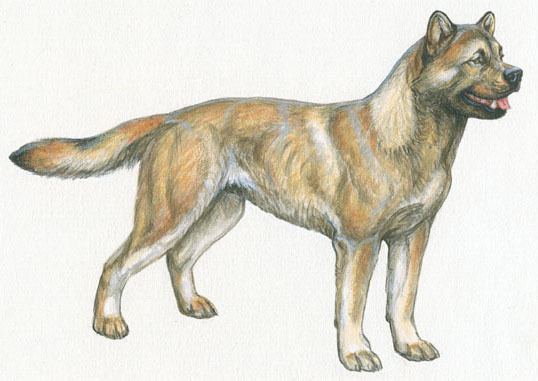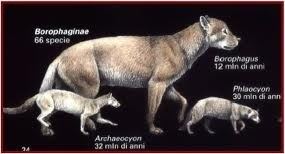Rank Subfamily | Scientific name Borophaginae Order Carnivores | |
 | ||
Similar Canidae, Hesperocyoninae, Borophagus, Aelurodon, Carnivores | ||
The subfamily Borophaginae is an extinct group of canids called "bone-crushing dogs" that were endemic to North America during the Oligocene to Pliocene and lived roughly 36—2.5 million years ago and existing for about 33.5 million years.
Contents

Origin

The Borophaginae apparently descended from the subfamily Hesperocyoninae. The earliest and most primitive borophagine is the genus Archaeocyon, which is a small fox-sized animal mostly found in the fossil beds in western North America. The borophagines soon diversified into several major groups. They evolved to become considerably larger than their predecessors, and filled a wide range of niches in late Cenozoic North America, from small omnivores to powerful, bear-sized carnivores, such as Epicyon.
Species

There are 66 identified borophagine species, including 18 new ones that range from the Orellan to Blancan ages. A phylogenetic analysis of the species was conducted using cladistic methods, with Hesperocyoninae as an archaic group of canids, as the outgroup. Aside from some transitional forms, Borophaginae can be organized into four major clades: Phlaocyonini, Cynarctina, Aelurodontina, and Borophagina (all erected as new tribes or subtribes). The Borophaginae begins with a group of small fox-sized genera, such as Archaeocyon, Oxetocyon, Otarocyon, and Rhizocyon, in the Orellan through early Arikareean stages. These canids reached their maximum diversity of species around 28 million years ago.

Often generically referred to as "bone-crushing dogs" for their powerful teeth and jaws, and hyena-like features (although their dentition was more primitive than that of hyenas), their fossils are abundant and widespread; in all likelihood, they were probably one of the top predators of their ecosystems. Their good fossil record has also allowed a detailed reconstruction of their phylogeny, showing that the group was highly diverse in its heyday. All Borophaginae had a small fifth toe on their rear feet (similar to the toes that bear dew claws on the front feet), where as all modern Caninae have only four toes normally.
Noteworthy genera in this group are Aelurodon, Epicyon, and Borophagus (=Osteoborus). According to Xiaoming Wang, the Borophaginae played broad ecological roles that are performed by at least three living carnivoran families, Canidae (which they were a part of), Hyaenidae, and Procyonidae.
Classification
Borophagine taxonomy, following Wang et al.
(million years=in existence)
Cladogram showing borophagine interrelationships, following Wang et al., figure 141:
Extinction
According to an analysis of the fossil record of North American fossil carnivorans, the decline of borophagines from a diversity of about 30 species 15 million years ago to extinction was largely driven by competition with felids and canines. Felids invaded the continent from Eurasia about 20 million years ago and were better ambush predators, in part due to their retractable claws. Climate change, which led to the replacement of North American forests with grasslands, may also have been a factor; borophagines were less suited to running down prey than canines.
